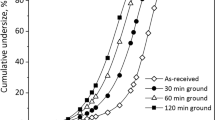Abstract
Tailings (flotation waste) that is formed during copper production may be considered in the class of valuable wastes due to the amount of copper it contains. Owing to the decreasing grade values in copper ores, utilization of wastes such as tailings that carry certain amounts of copper as secondary sources has become a necessity in both the economic and environmental sense. This study investigated the usage conditions of five different ammonia salts as leaching reactants for the purpose of selective extraction of copper from tailings. For this purpose, the effects of parameters such as leaching temperature and leaching time were examined at different concentrations of ammonium hydroxide, ammonium carbonate, ammonium nitrate, ammonium chloride, and ammonium persulfate. The copper extraction efficiency in the case of using the aforementioned salts by themselves were listed as (NH4)2CO3 (73%) > (NH4)2S2O8 (69%) > NH4OH (64%) > NH4Cl (42%) > NH4NO3 (40%). The highest copper extraction efficiency was obtained in the leaching process that was conducted with the solutions obtained by mixing ammonia salts in the best conditions. Accordingly, as a result of 6 h of leaching at 30 °C in the presence of 22.5% NH4OH and 100 g/L (NH4)2S2O8, 91.47% of the copper was transferred into the solution, while iron was not transferred. The obtained results showed that copper could be selectively recovered from tailings.











Similar content being viewed by others
References
Tulgar HE (1987) Metallurgy of non-ferrous metals (in Turkish language), part I, 2nd edn, İTÜ library, 842, p: 26–141. İstanbul, Turkey
Turan MD, Sarı ZA, Miller JD (2017) Leaching of blended copper slag in microwave oven. Trans Non-Ferrous Met Soc China 27:1404–1410
Carranza F, Romero R, Mazuelos A, Iglesias N, Forcat O (2009) Biorecovery of copper from converter slags: Slags characterization and exploratory ferric leaching tests. Hydrometallurgy 97:39–45
Herreros O, Quiroz R, Manzano E, Bou C, Vinals J (1998) Copper extraction from reverberatory and flash furnace slag by chlorine leaching. Hydrometallurgy 49:87–101
Padilla AG, Cisternas AL, Cueto YJ (2008) On the optimization of heap leaching. Miner Eng 21(9):673–678
Xie Y, Xu Y, Yan L, Yang R (2005) Recovery of nickel copper and cobalt from low-grade Ni-Cu sulfuride tailings. Hydrometallurgy 80:54–58
Ramakokovhu MM, Kasaini H, Mbaya RKK (2012) Leaching characteristics of upgraded copper flotation tailings. Int Sch Sci Res & Innov 6(8):853–857
Bingöl D, Canbazoğlu M, Aydoğan S (2005) Dissolution kinetics of malachite in ammonia/ammonium carbonate leaching. Hydrometallurgy 76:55–62
Feng D, Van Deventer JSJ (2002) Leaching behaviour of sulphides in ammoniacal thiosulphate systems. Hydrometallurgy 63:189–200
Thompson G, Senanayake G (2018) Effect of iron(II) and manganese(II) on oxidation and co-precipitation of cobalt(II) in ammonia/ammonium carbonate solutions during aeration – an update and insight to cobalt losses in the Caron process for laterite ores. Hydrometallurgy 181:53–63
Asselin E (2008) Thermochemical aspects of the Fe, Ni & Co-NH3-H2O systems relevant to the caron process. Hydrometallurgy- 6th international symposium. SME, Littleton, pp 522–531
Lotens JP, Wesker E (1987) The behaviour of Sulphur in the oxidative leaching of sulphidic minerals. Hydrometall 18:39–54
Turan MD (2014) Direct selective leaching of chalcopyrite concentrate. Can Metall Q 53(4):444–449
Turan MD, Kalender L (2014) An alternative approach for the metal production from copper slag. Curr Phys Chem 4:313–317
Author information
Authors and Affiliations
Corresponding author
Ethics declarations
Conflict of Interest
The authors declare that they have no conflict of interest.
Additional information
Publisher’s Note
Springer Nature remains neutral with regard to jurisdictional claims in published maps and institutional affiliations.
Rights and permissions
About this article
Cite this article
Turan, M.D., Orhan, R., Turan, M. et al. Use of Ammonia Salts in Selective Copper Extraction from Tailings. Mining, Metallurgy & Exploration 37, 1349–1356 (2020). https://doi.org/10.1007/s42461-020-00241-6
Received:
Accepted:
Published:
Issue Date:
DOI: https://doi.org/10.1007/s42461-020-00241-6




